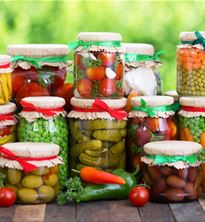

sauces
Prepare some of these canned at home is complicated because even slightly acid or acids not put at risk botulism. For example, the addition of meat or fish in tomato sauce reduces acidity making the prepared a suitable "land" for the proliferation of the bacteria spores. It is best to prepare sauces in convenient portions and store in the freezer. The cold freezes the microbial activity in preventing the growth of microorganisms and greatly reduces the enzyme activity. Retention times vary depending on the product and freezer. In the instruction book shows the times for the different categories of food.
pickled vegetables
Brine is an excellent system for the conservation of the plant, but the salt concentration must be corrected (at least 100 g of salt per liter of water) to avoid the risk botulinum. When plants are submerged in brine, natural fermentation by microorganisms which convert carbohydrates into organic acids (lactic acid) mainly starts. It is vital not remove microorganisms from the brine, which usually form a white layer on the surface, such as in the case of olives.
canned tomatoes
Tomato preparations, as it passed, concentrated and stripped, are the most widespread in the home. In general, the pH ranges from 3.9 Tomato 4.6, and should use these cultivars more acidic (pH <4.3) to reduce pasteurization times. If tomatoes are just acids must add the lemon juice (two teaspoons per liter), or citric acid. Alternatively, you can use vinegar, although the taste may change. After washing tomatoes, vegetable crushed with passes to separate the skins and seeds from the pulp (if necessary acidify) is passed to the filling containers or bottles with screw or star (bottle) and pasteurization . If the filling of the vessels is carried out cold, pasteurization is carried out from water at room temperature and should last at least 40 minutes by boiling for containers of one liter and 35 liters for Middle. In the tomato puree after pasteurization can be seen in the bottle formation of a liquid phase separate from polpa.ma not have to worry about as it is normal. For the preparation of the concentrate, when they receive the past or from tomatoes in pieces, excess water by filtration with a cotton or linen cloth (bag-shaped) is deleted; the process is very slow. Alternatively last for about 2-3 hours at medium-low heat without lid for all hot and then proceed to pasteurization treatment from hot (at the same temperature of the concentrate) water pot cooking.
peeled tomatoes
After selecting the ripe fruit and free of blemishes, wash in running water and do in each tomato cut a cross. Put a pan and when the water starts boiling bleach for 2-3 minutes. Remove the tomatoes with a "skimmer", let them cool, remove the skin and potting. Close the jars and pasteurize the same as described for the past mode.
Source: http://www.ilfattoalimentare.it/conserve-di-pomodoro-rischi.html